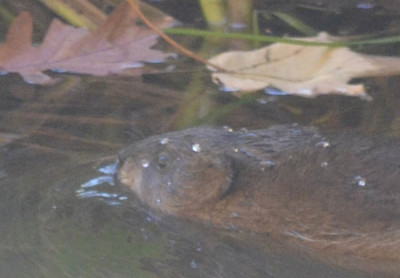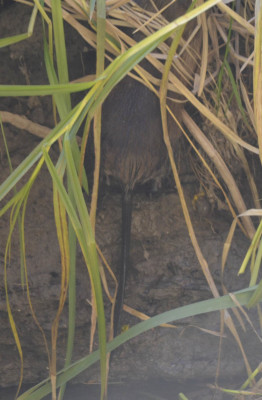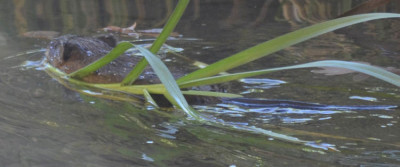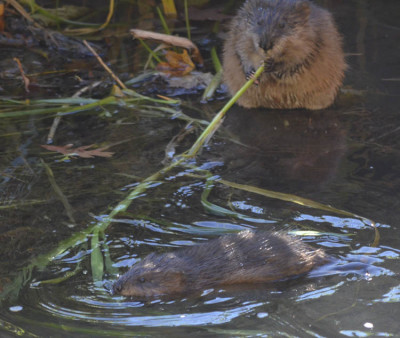One sunny afternoon in October, I went for a ramble through the Rattray. The sun was a bit west of noon and shining fiercely into my eyes. Even so, I caught a glimpse of movement near the mud bank of Sheridan Creek. A Muskrat was swimming down the stream towing a long green spear of leaves. Then there was a ferocious amount of splashing, and I realized there were actually two animals. They tussled briefly, then settled down and began eating.
Young Muskrats Munch While the Dogs Walk On
Somewhat to my surprise, while I watched the Muskrats from the boardwalk path, a steady stream of dogs and their walkers passed beside me. Not one of the dogs noticed, sniffed, barked or glanced at the two furry footballs only a dozen yards away. Remind me not to count on a dog to save me from starvation in the wilderness!
The Muskrats seemed small to me, so they were probably born this year. For a while the one tried to feed from the same leaves as its sibling but eventually gave up and started searching for food of its own. The one that had dragged the long green stems to this wider bank along the shore seemed to be most interested in the ground level end of the plant. Perhaps the thicker, whiter stem end was more palatable than the tougher stringier leaves?
Fine Swamp Dining
These two were feeding on some of the surrounding vegetation. I’m not sure whether this was one was eating a cattail or one of the reeds that grow amongst them.
According to the website for the Canadian Museum of Nature also eat freshwater mussels and occasionally frogs and small turtles.
I used to think that freshwater “mussels” were some unusual type of shellfish. I was surprised to learn that the freshwater creatures I had always called “clams” are actually mussels.
If you notice an unusual number of “clam” shells near a dock on a lake or river where Muskrats live, you may actually be seeing the remains of the Muskrats’ supper!

Notice the water beads on this Muskrat. It must be nicely dry.
Unlike some mammals, according to the Minnesota Department of Natural Resources website, Muskrats do not store food for the winter. Instead, they usually go searching for plants to eat. They have been known to swim under the ice to do this. According the Museum of Nature, they can hold their breath for up to 15 minutes, so staying under the ice briefly probably isn’t a big problem for them.
“Rat for Lunch, Rat for Lunch, Yum, Delicious, Munch Munch, Munch”
Copyright: Jack Prelutsky
Although I wouldn’t want to eat one, Muskrats are fair game for marsh land predators. Mink, foxes, coyotes, lynx, and even raccoons are known to eat Muskrats. Larger birds of prey sometimes catch young ones, too.
 You can see the un-furred tail is slightly flattened vertically if you can make it out despite the glare.
You can see the un-furred tail is slightly flattened vertically if you can make it out despite the glare.
To keep up with this high rate of loss, muskrat females can have up to 10 pups in each litter. In Minnesota, they may have as many as 3 broods of young per year.(source: Minnesota Department of Natural Resources.)
Related Reading
Join In
Do you see Muskrats regularly? Are they a nuisance for tunneling into the banks? Do you have a guess what critter I saw in the stream? Please share your views with a comment.



